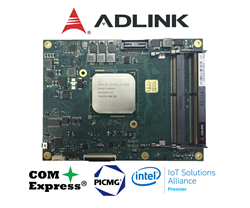Adlink Technology announced this week its initial computer-on-module (COM) based on the latest PCI Industrial Computer Manufacturers Group (PICMG) COM Express 3.0 specification with new Type 7 pinout, for which the company’s lead development efforts to bring a server-grade platform and 10 Gigabit Ethernet (GbE) capabilities to a COM form factor.
Adlink’s Express-BD7 targets customers building space-constrained systems in industrial automation and data communication, such as virtualization, edge computing or other numerical applications, that require high density CPU cores balanced by reasonable power consumption.
Adlink’s Express-BD7 provides up to 32GB dual channel DDR4 at 1867/2133/2400MHz ECC (dependent on SoC SKU), up to eight PCIe x1 (Gen2), two PCIe x4, one PCIe x16 (Gen3), two SATA 6 Gb/s and four USB 3.0/2.0. The module comes with a build option for an Extreme Rugged operating temperature range of -40°C to +85°C and supports Adlink Smart Embedded Management Agent (SEMA) that enables remote management and control of distributed devices.
Adlink’s SEMA-equipped devices connect seamlessly to the SEMA Cloud solution to enable remote monitoring, autonomous status analysis, custom data collection, and initiation of appropriate actions. All collected data, including sensor measurements and management commands, are available from any place, at any time via encrypted data connection.
The COM Express standard’s new Type 7 pinout, as compared to the Type 6 pinout, does away with all graphics support and replaces it with up to four 10GbE ports and an additional eight PCIe ports, bringing the total PCIe support to up to 32 PCIe lanes. The Type 7 pinout has been specifically tailored to leverage all the functions of low power, headless server-grade SoCs with a TDP below 65 Watts.
The Intel Xeon SoCs featured in Adlink’s Express-BD7 support up to 16 CPU processor cores, 32 PCIe lanes, and multiple 10GbE ports. In addition, the Type 7 pinout brings out 10GBase-KR signals, meaning the carrier board designer can choose between KR-to-KR, KR-to-optical fiber or KR-to-copper. A Network Controller Sideband Interface (NC-SI) bus is also supported, allowing for Intelligent Platform Management Interface (IPMI) Board Management Controller (BMC) support on the carrier board.
Adlink is playing a leading role in the PICMG subcommittee that is currently defining the new COM Express 3.0 specification. The committee, which started its work late last year, is chaired by Adlink’s Jeff Munch, CTO of Americas, and has just published a preview of the new specification.
The preview defines the new Type 7 pinout and allows module manufacturers and customers to start designs before the full specifications are published, which is expected to be the end of the third quarter of this year.
“ADLINK has worked closely with fellow PICMG members to develop this latest module specification and pinout to leverage a new type of low power, server-level silicon that appeared on the market at the end of 2015. Type 7 is tailor-made to accommodate these low power, server-oriented SoCs. In addition to the obvious use case in 10GbE data communication, we see many others application areas for these products, such as virtualization, real-time control and even graphics applications using discrete GPU solutions over PCIe x16, ” said Alex Wang, product manager for COM Express modules at Adlink. “Our COM Express Type 7 roadmap focuses on creating products with advanced computing performance and multi-core capabilities. Our COM Express products are off-the-shelf building blocks that allow our customers to focus on adding value to their carrier boards, reducing their total cost-of-ownership and expediting their time-to-market.”




